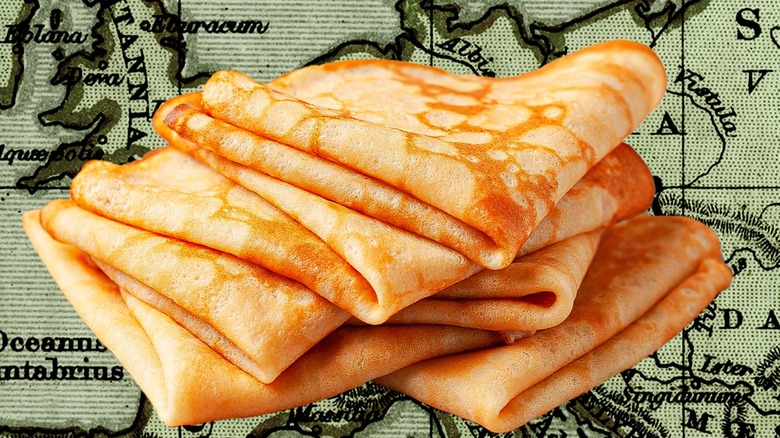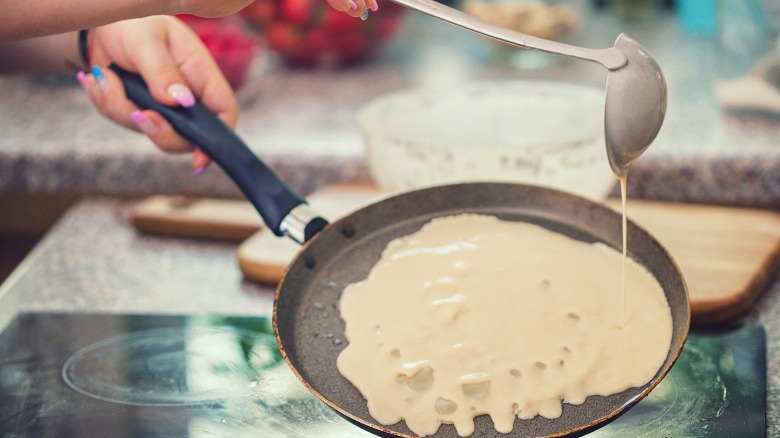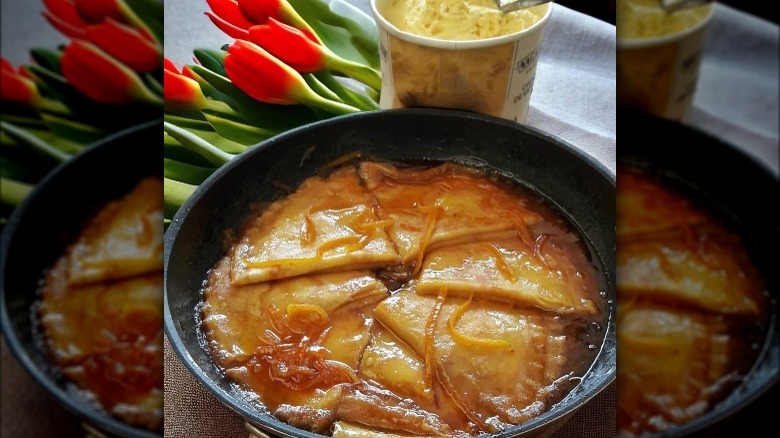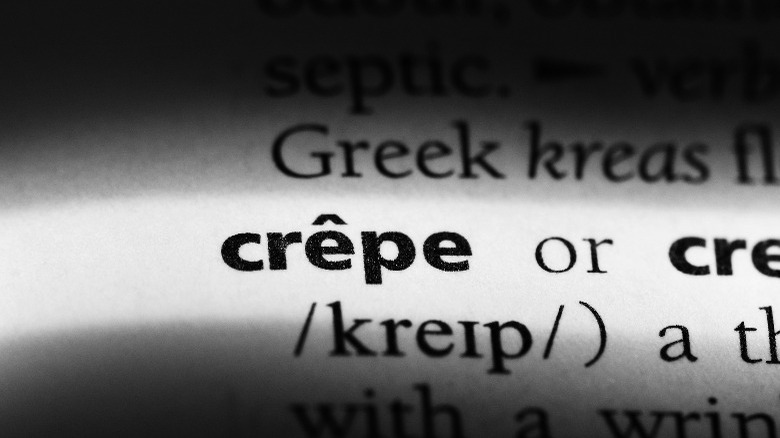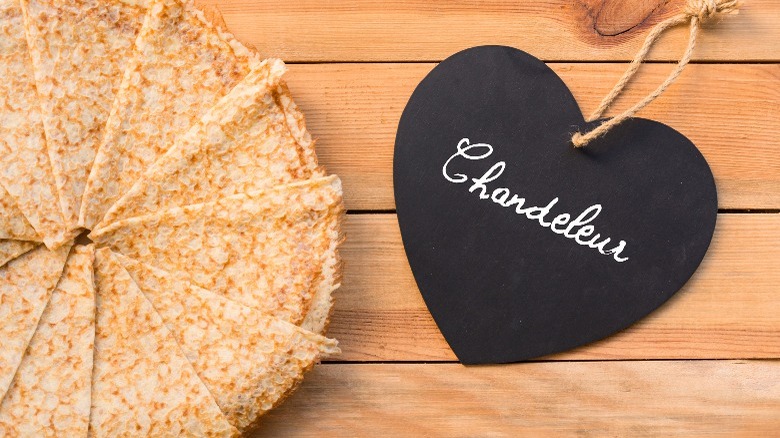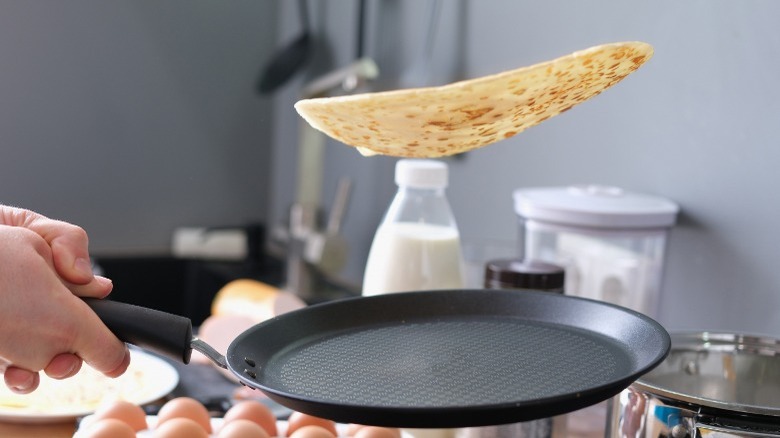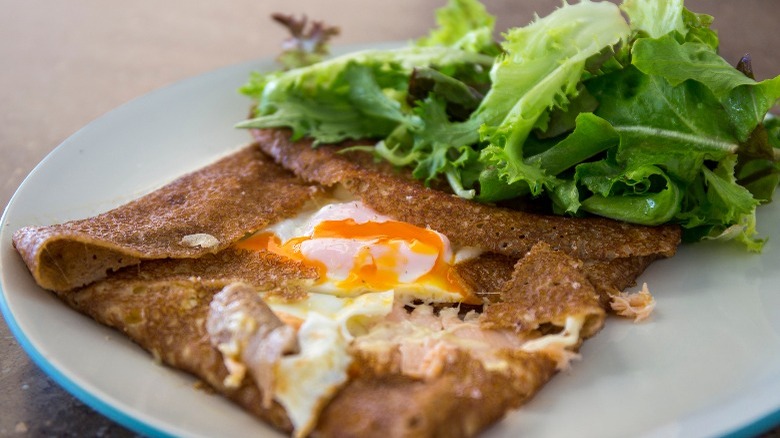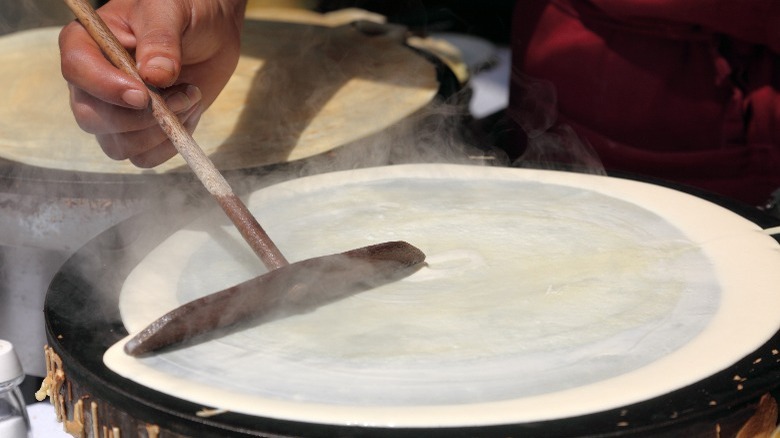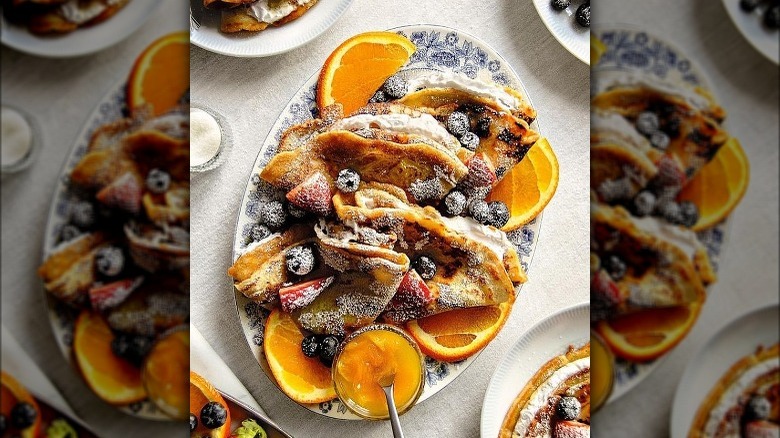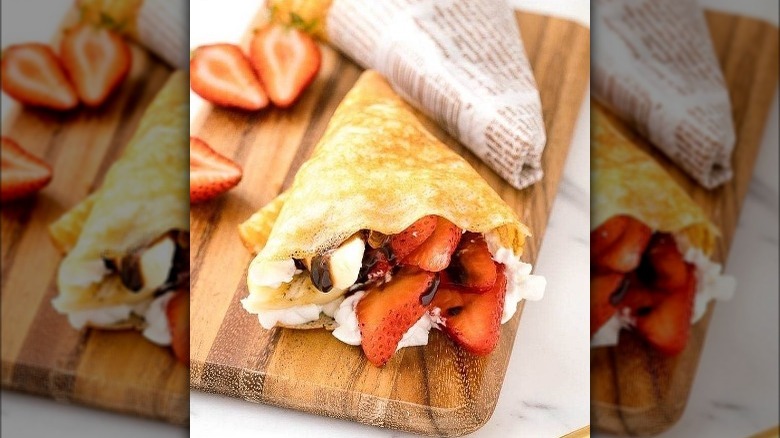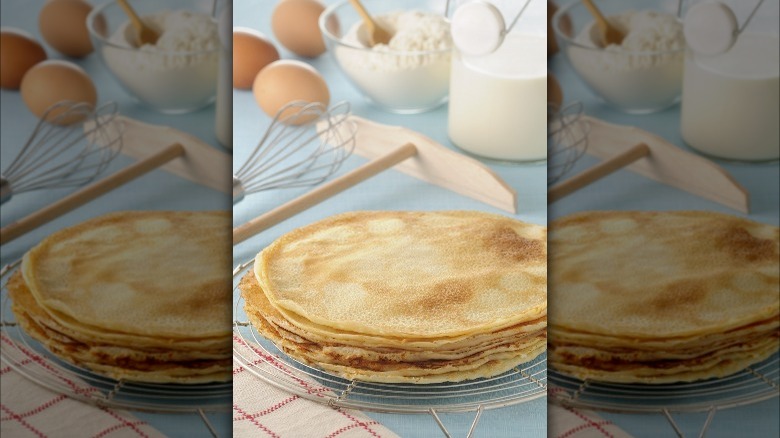The Origin Of Crêpes Is Shrouded In Mystery
We all love crêpes, thin French pancakes with crispy edges and a wide range of sweet or savory fillings and toppings. Different from the pancakes we enjoy in the U.S. — which contain baking powder for a light, fluffy texture — crêpes may be a French word, but what do we really know about where they originated? It's all a bit of a mystery.
Some say the crêpe was the result of a happy accident in 13th-century Brittany. Other stories date these delights back hundreds of years to Candlemas celebrations in France. The crêpe's origins may be shrouded in mystery, but that lends itself to some interesting stories.
We'll dive deep into some tales surrounding the roots of crêpes, look at how crêpes are enjoyed worldwide today, and even explain the difference between crêpes, galettes, and pancakes. Along the way, we'll meet a real-life group of enthusiasts who dedicate themselves to keeping the traditional galette alive.
Finally, we'll show you some delicious ways to enjoy your crêpes, whether you prefer sweet or savory fillings, as well as how to make them yourself at home. Crêpes cravings incoming!
A happy accident
Who first created the crêpe, and just how did they come up with the idea? One popular tale tells that the origin of the crêpe was, in fact, a "happy accident."
Cast your mind back to Brittany, sometime around the 13th century. A housewife was preparing dinner for her family — though some versions of the story say it was a maid cooking for her master — when she accidentally spilled some buckwheat porridge from a kettle in the fireplace. This mixture landed on a hot pan and immediately began to cook. Not wanting to waste the food, she tasted the results. It was surprisingly delicious, and the crêpe was born!
While there's no evidence proving that this story ever really happened, it's by far the most common origin story for crêpes, and it's the reason many French people, and people worldwide, think of Brittany as the home of the crêpe. However, it's far from the only story about where crêpes came from.
The origins of Crêpes Suzette
One of the most popular crêpe dishes, crêpes Suzette, has its own origin story. In 1895, Henri Charpentier, a 16-year-old Commis des rang at the Café de Paris in Monte Carlo, was preparing dinner for the Prince of Wales, later King Edward VII of England.
The story goes that as he was mixing the sauce for the dish, Charpentier added his own brandy blend to the pan, which caught fire. Unphased, he pretended that was what he had intended to happen and served the dish to the waiting guests.
Supposedly, the prince loved the dish, naming it crêpes Suzette after a beautiful guest dining at the table. Today crêpes Suzette is popular worldwide, traditionally made with a sauce of caramelized sugar, butter, tangerine or orange juice and zest, and liqueur — generally Grand Marnier or Triple Sec. The highlight of this dish is that it's usually brought in a pan to the table and flambéed in front of diners.
Where does the word Crêpe come from?
At first glance, the word crêpe looks rather strange. Its pronunciation rhymes with yep, but where does it come from? The word has its origins in the old French word crespe, meaning crispy. This, in turn, comes from the Latin word crispa, meaning curly.
The word makes a lot of sense when you think about what a typical crêpe looks like. Crêpes are thin and somewhat wavy, with crispy browned edges — very different from the thick, fluffy pancakes we're used to for breakfast in the U.S.
The little hat above the letter e — known as a circumflex — represents that there was once a letter s used in the word, but over time, as the language evolved, it was deleted. Today, in many countries, we call crêpes pancakes, though strictly speaking, they're two different things. In France, you may also hear the word galette used, though, again, galettes are a completely different thing to crêpes.
Le Jour de Crêpes/Candlemas
We've all heard of Pancake Day or Shrove Tuesday, which always lands 47 days before Easter Sunday. There's even a second Pancake Day on September 26. But did you know that crêpes have their own day too? Mark your calendars for February 2 if you want to celebrate Le Jour des Crêpes, also known as Candlemas or La Chandeleur in France. Recognize the date? That's because it's also Groundhog Day in the U.S.
The word chandeleur originates from the French word for candle, and men of the clergy would once light candles, bless them, then hand them out for mass. This is also why La Chandeleur is often called Fête de la Lumière, or celebration of light.
This day was first celebrated way back in the year 472 when French Catholic pilgrims visiting Rome for Candlemas were served crêpes by Pope Celsio I. Traditionally; the day marks the transition from winter to spring.
Today in France, crêpes are served on this day as their golden color and circular shape represent the sun and the circle of life as flowers bloom and greenery returns for the spring season. Preparing crêpes is also said to bring good fortune for the coming year, a superstition dating back to Roman times.
Superstitions surrounding crêpes
Speaking of superstitions, there are quite a few that are common in France surrounding the preparation and eating of crêpes, particularly on La Chandeleur. Some stories say you should hold a gold ring or coin in your left hand as you flip the crêpe in the pan with your right hand. This is said to bring wealth for the coming year, though some say it brings good weather. Just make sure the crêpe doesn't fall on the floor while you're tossing it.
Other tales involve cooking a crêpe with a gold coin on top for wealth and good luck. Then there's the one about hiding the first crêpe made in a drawer to bring good luck and prosperity to the household for the coming year.
One French proverb says in "Pancake: A Global History" by Ken Albala, "Manger des crêpes à la chandeleur apporte un an de bonheur," which means, "To eat crêpes on Candlemas, Brings a year of happiness." Another says, "Si point ne veut de blé charbonneux mange des crêpes à la Chandeleur," meaning "If you don't want to have black wheat Eat crêpes for La Chandeleu," referring to the belief that preparing crêpes on this day would bring fertile crops, according to Sacre Blue!.
Crêpes vs galettes vs pancakes: What's the difference?
Have you ever wondered what the difference is between crêpes, galettes, and pancakes? In the U.S. and many other countries, the word crêpes and pancakes are often used interchangeably.
Some say it's all in the filling. Both crêpes and galettes are thin, light, and crispy. But where a crêpe is usually made with wheat flour and has a sweet filling, galettes are generally made with buckwheat and savory fillings. Even more confusingly, crêpes are made with buckwheat in some parts of France.
If you've ever eaten a ham, cheese, and egg crêpe, it's likely you've had a galette, though depending on where in France you are, you'll sometimes hear it called a crêpe. Pancakes, on the other hand, are entirely different. The ones we eat in the U.S. are light and fluffy thanks to the addition of baking soda or baking powder, and they're usually smaller and thicker than crêpes.
In the late 18th century, when there was a shortage of milk, a mixture of wine and water was often used to make crêpes. Today, milk — or plant-based milk — is most commonly used to make crêpes and pancakes, while galettes simply use water. Don't worry too much about what you call crêpes if you're traveling in France — nobody will judge you if you get it wrong.
The Brotherhood of the Galette
There are some people out there who are very strict about what a galette is compared to a crêpe. In fact, some are so serious about the difference between the two that they've set up a dedicated group to keep the traditional galette alive.
Don't believe us? The Brotherhood of the Galette is a French group created in 1998 that aims to celebrate traditional Breton galettes. The members wear green costumes that represent local agriculture, with buckwheat flowers embroidered on the sleeves and flat hats that resemble galettes.
The Brotherhood of the Galette has its headquarters in Pipriac, a city in Northern Brittany, and today has 25 members, all dedicated to preserving the tradition of the galette and protecting the recipe and its ingredients. The traditional recipe uses buckwheat flour, water, and coarse salt, sometimes adding an egg.
Authentic galettes have a darker brown color than crêpes due to the buckwheat, and they always have a savory filling. A galette complète is the traditional way to serve these buckwheat pancakes, filled with ham, egg, and grated Emmental cheese.
What makes a crêpe, a crêpe?
So we now know the difference between crêpes, galettes, and pancakes, but what makes a crêpe a crêpe? Traditionally, crêpes are made with wheat flour, eggs, and milk or water. You'll also need a little salt and sugar, as well as melted butter or oil, for cooking the crêpes. In some recipes, add a little melted butter to the batter for richness.
In parts of France, particularly the northern regions such as Brittany, buckwheat is traditionally used instead of wheat flour. One thing everyone is in agreement about, though, is the fast cooking time for crêpes. It usually only takes about 45 seconds per side to get those crisp brown edges, after which you flip the crêpe and give it another 5-10 seconds.
What is the most important thing about cooking crêpes? The batter should be spread out thinly in the hot, greased pan. Watch any street vendor make crêpes, and you'll see just how thinly the batter is spread.
Crêpes around the world
It seems like no matter where you go in the world; every country has its own version of crêpes. Travel to Germany or Austria, and you'll find palatschinken, slightly thicker than French crêpes and served rolled up, filled with apricot jam. In Galicia, Spain, you'll find filloas, traditionally made with pork fat or lard to grease the pan and served with fillings ranging from honey or fruit to pork.
Japanese crêpes, or kerupon, are thin, sweet pancakes usually rolled into a cone shape and filled with ingredients such as custard, chocolate, fruits, or whipped cream. The Japanese also serve savory wheat flour crêpes in most restaurants, packed with teriyaki pork, chicken, or other savory delights. Head for Norway to enjoy pannekake, which are similar in style to French crêpes, filled with cream cheese and jam. These are commonly packed for picnics or eating on the go.
Popular crêpe fillings
With fillings ranging from sweet to savory, crêpes can be enjoyed by everyone. In France, crêpes are commonly folded into a triangle shape and sprinkled with sugar, the most popular way for them to be served. Other toppings and fillings include honey, Nutella, jam, fruits, and even cider.
To enjoy the most authentic crêpes, head for an ancient crêperie in Place au Buerre in Brittany's oldest city, Quimper. While you're here, give crêpes Suzette a try, where crêpes are served in a sauce made from caramelized sugar, butter, orange juice, and Grand Marnier or Triple Sec, then flambéed at your table.
Outside of France, fillings and toppings vary. In the U.K., crêpes most commonly come with lemon and a sprinkling of sugar or Nutella chocolate spread. In Japan, crêpes are commonly served rolled up and filled with a variety of sweet ingredients, from custard and fruits to chocolate.
Then there are the savory fillings. In France, you'll usually find these served inside a galette, made with buckwheat rather than a crêpe. The most popular of these is a galette complète filled with grated Emmental cheese, ham, and an egg, folded in such a way that the egg is visible in the center of the parcel. Other popular fillings include mushrooms, spinach, and other types of cheese.
Making crêpes at home
Anyone can make crêpes at home, so you don't need to head for a crêperie to indulge. The traditional crêpe recipe for French crêpes includes flour, eggs, milk, and melted butter. As well as using the butter to grease the pan, a little can be added to the batter to ensure it's smooth and rich.
It's possible to substitute plant-based milk for the milk and vegan egg substitutes for the eggs. Or you could make a galette, a savory buckwheat pancake that uses buckwheat flour, salt, and water and can be filled with your favorite vegetables, cheese, or other savory ingredients for a light lunch or main course.
What to put on your crêpes? The options are limitless. Though crêpes are traditionally sweet, there's nothing to stop you from adding savory ingredients to yours, like the classic combo of bacon and maple syrup — you might even want to consider trying ham and Gruyère crêpes. Sprinkle them with sugar and a little lemon juice or fill them with jam, chocolate spread, or cream cheese and roll them up for snacking on the go. Make crêpes Suzette with orange juice, sugar, butter, and liqueur, for a special dessert, or serve your crêpes with fresh fruit and whipped cream or ice cream.
Don't have time to prepare crêpes at home? You could buy a pre-made mix to take the hard work out of making your favorite sweet treats for breakfast, brunch, or dessert. Or buy ready-made crêpes at most major stores — you'll even find filled varieties that are great for snacking on the go or packing in kids' lunchboxes.
